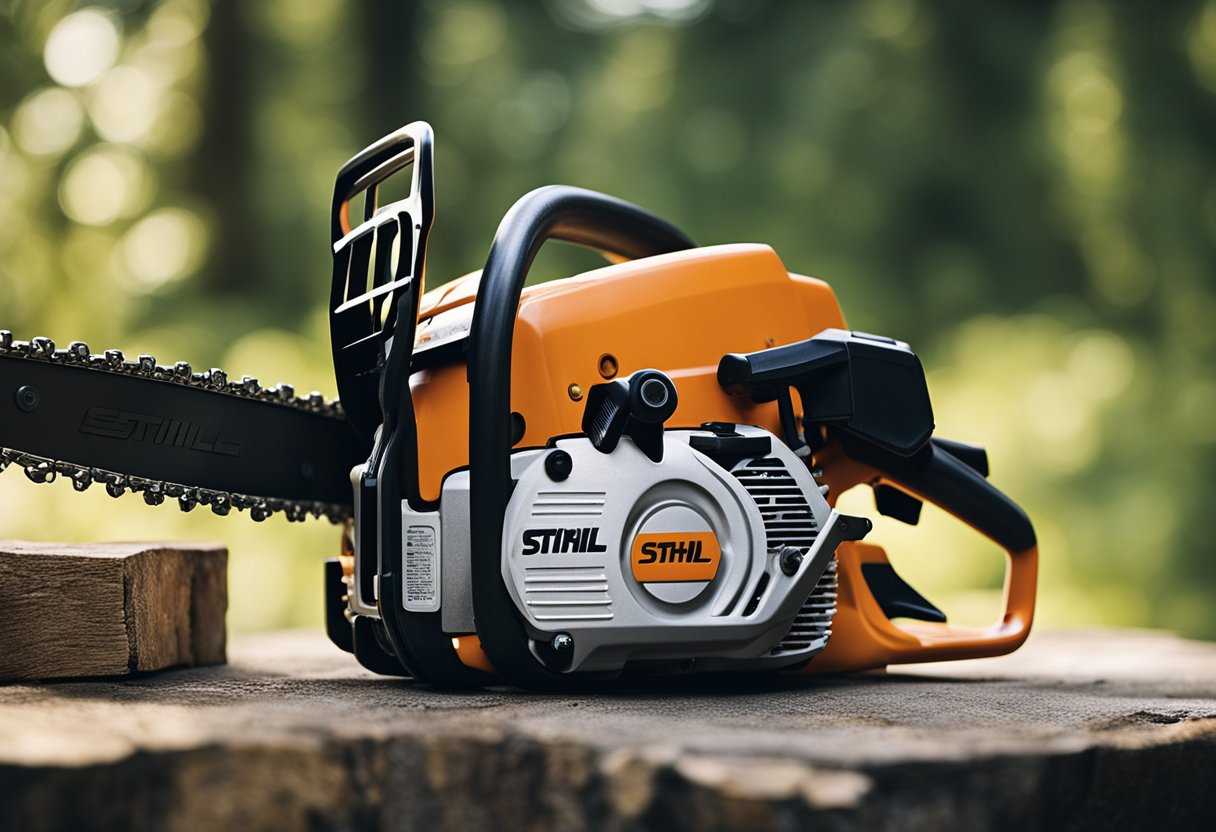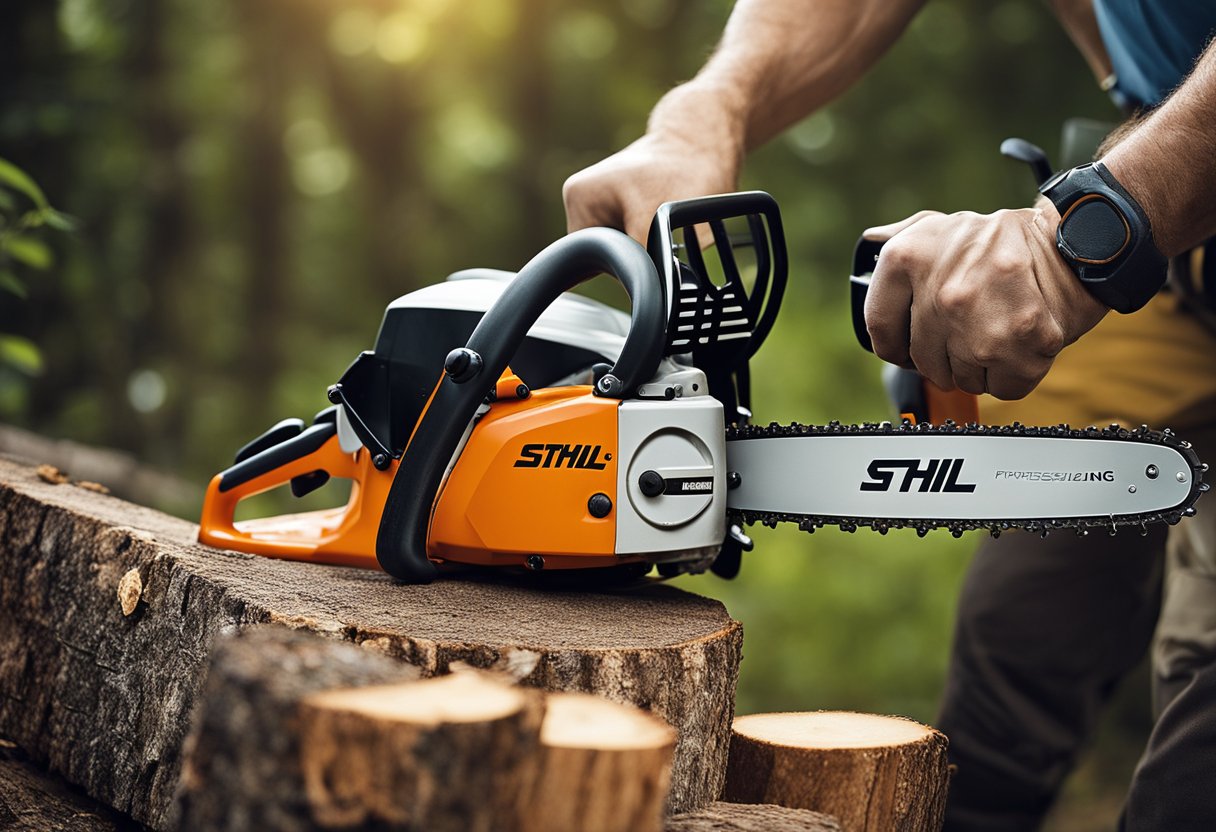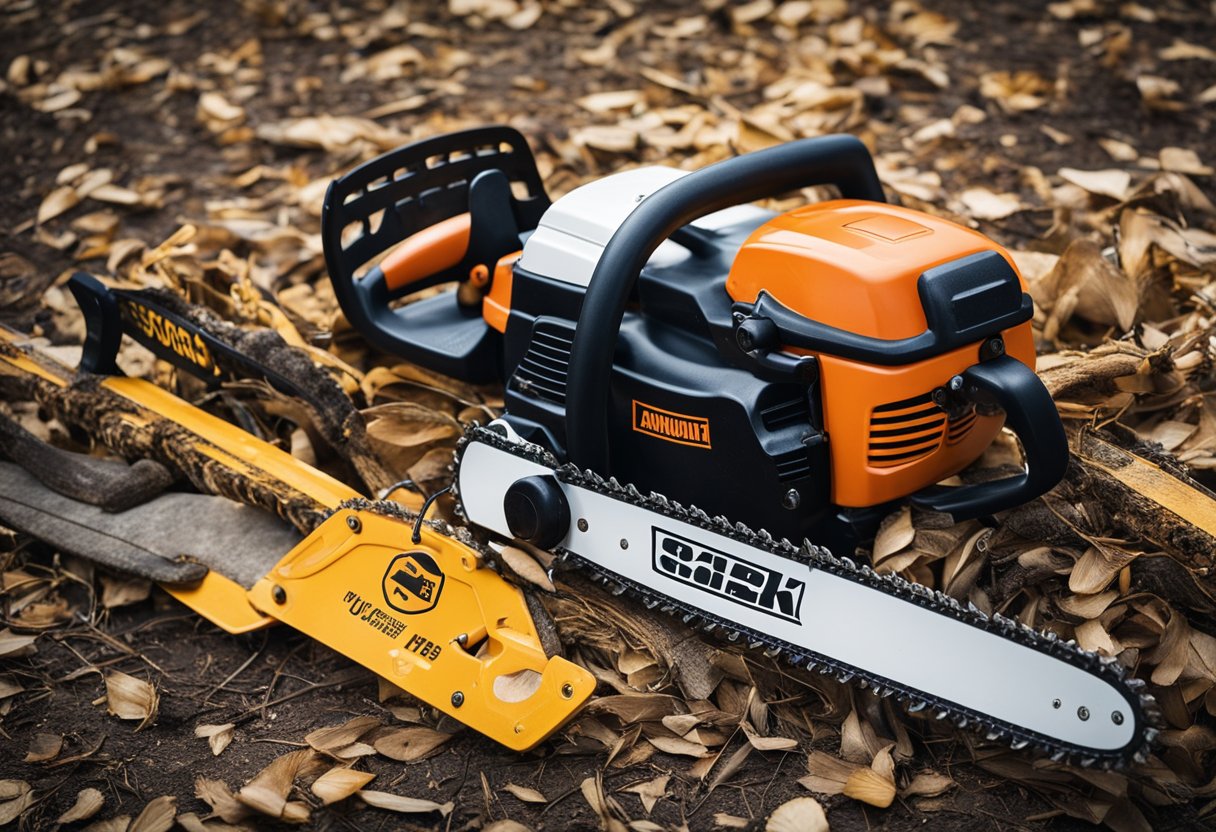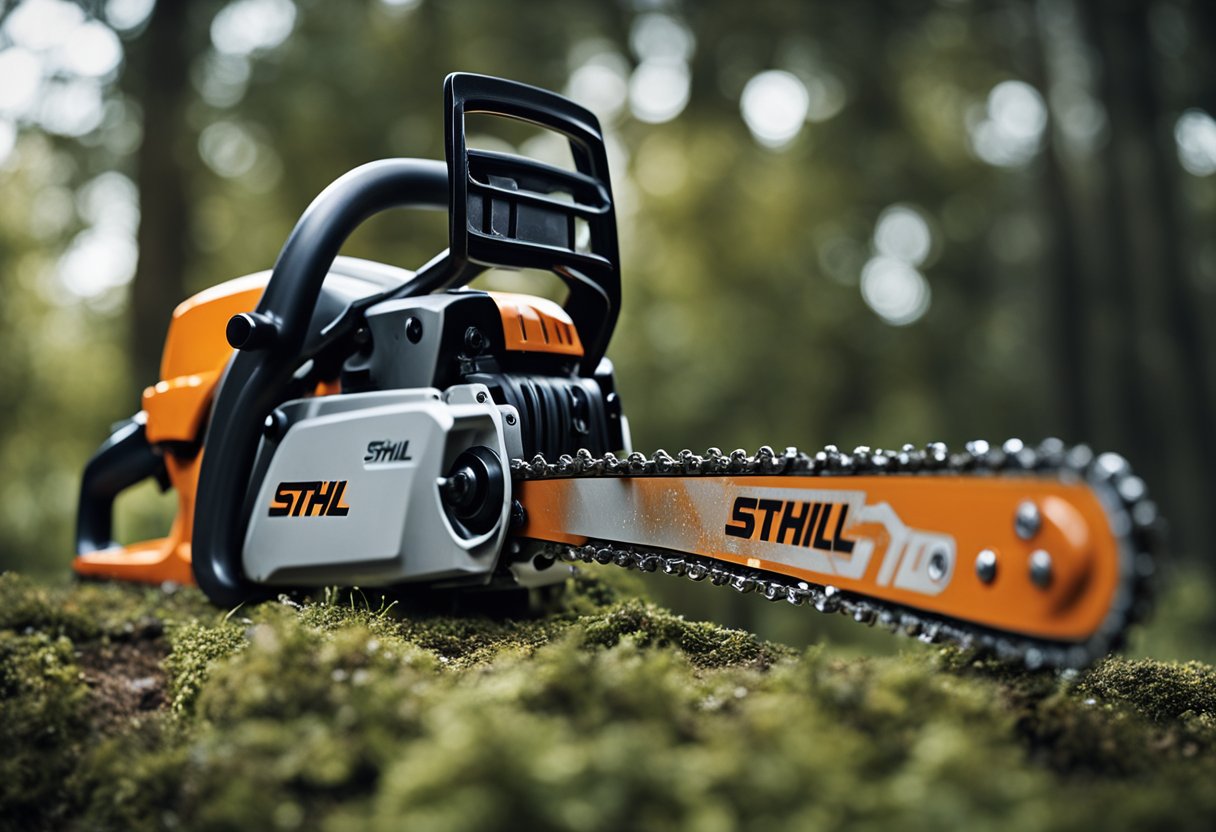I have extensive experience working with chainsaws, and one issue that I have encountered on multiple occasions is a Stihl chainsaw chain that won’t spin freely. This problem can be frustrating, especially if you’re in the middle of a job and need to make quick progress. Fortunately, there are several steps you can take to identify and fix the issue.
To begin, it’s essential to understand how a chainsaw works. The chainsaw mechanism is made up of several components, including the engine, chain, bar, clutch, and brake. Each of these parts plays a crucial role in the chainsaw’s operation, and if one part fails, it can cause the entire system to malfunction. Identifying the problem is the first step in resolving the issue.
Once you’ve identified the problem, you can begin troubleshooting. There are several potential causes of a chainsaw chain that won’t spin freely, including issues with the chain and bar, problems with the clutch and brake, and general maintenance issues. By following a few simple steps, you can get your Stihl chainsaw up and running again in no time.
Key Takeways
- Understanding how a chainsaw works is crucial in identifying the problem when a Stihl chainsaw chain won’t spin freely.
- Checking the chain and bar, inspecting the clutch and brake, and maintaining the chainsaw are essential steps in troubleshooting the issue.
- Proper safety precautions must be taken when working with a chainsaw to prevent injury.
Understanding the Chainsaw Mechanism
As someone who has worked with chainsaws for a while, I have come to understand the intricate mechanism that makes it possible for the chainsaw to function. A chainsaw has several components that work together to ensure that the chain rotates at high speed to cut through wood and other materials.
The main components of a chainsaw include the engine, chain, sprocket, clutch, bar, and chain brake. The engine is responsible for powering the chainsaw and driving the chain. The chain is what cuts through the material being worked on. The sprocket is what drives the chain, and the clutch is what engages and disengages the chain.
The bar is the long, flat metal piece that guides the chain and supports it. The chain brake is a safety feature that stops the chain from rotating when the chainsaw is not in use. The clutch drum is the part of the chainsaw that the chain wraps around, and the clutch assembly is the mechanism that engages and disengages the clutch.
The centrifugal clutch is a type of clutch that uses centrifugal force to engage and disengage the clutch. The drive sprocket is the part of the chainsaw that the chain wraps around to drive it. The clutch springs are what hold the clutch assembly in place, and the clutch housing is the part of the chainsaw that the clutch is housed in.
The spark plug is what ignites the fuel in the engine, and the spark plug wire is what delivers the spark to the spark plug. The piston is what moves up and down in the cylinder to create the power that drives the chainsaw. The air filter is what filters the air that the engine needs to function, and the fuel ratio is the ratio of fuel to oil that the engine needs to run properly.
The throttle is what controls the speed of the engine, and the choke is what helps the engine start when it is cold. The crankshaft is what converts the up and down motion of the piston into rotational motion that drives the chain.
Understanding how each of these components works together is essential in troubleshooting issues with a chainsaw, such as when the chainsaw chain won’t spin freely. By having a clear understanding of the chainsaw mechanism, you can identify the root cause of the problem and take the necessary steps to fix it.
Identifying the Problem
https://www.youtube.com/watch?v=iyMBHm5PGMg&embed=true
As a professional logger, I have come across many issues with chainsaws, and one of the most common ones is when the chainsaw chain won’t spin freely. This issue can be frustrating, especially when you have a lot of work to do. In this section, I will help you identify the problem and provide some solutions to get your chainsaw back to working order.
One of the most common causes of the chain not spinning freely is when it gets locked or stuck. This can be caused by a damaged clutch, which can also cause the engine to struggle to engage the power needed to rotate the chain. Additionally, the guide bar or chain itself can be damaged, leading to wobbling and other problems that can prevent the chain from rotating smoothly.
Another possible cause for the chain not spinning freely is a bent guide bar. This can stop the chain from spinning and cause other problems. To check if this is the issue, remove the saw’s bar and chain and inspect the guide bar. If it is bent, replace it with a new one.
A worn-out clutch band drum brake can also cause the chain to not turn. If the clutch band is worn out, the motor will run, but the clutch band will not engage the clutch drum, causing the chain to not turn. Make sure that the stop lever is disengaged and check the clutch band drum brake to see if it is worn out.
In summary, identifying the problem when your Stihl chainsaw chain won’t spin freely can save you time and money. By checking the clutch, guide bar, and clutch band drum brake, you can pinpoint the issue and take the necessary steps to fix it.
Checking the Chain and Bar
https://www.youtube.com/watch?v=QDIVR3JQDb0&embed=true
When a Stihl chainsaw chain won’t spin freely, it’s important to check the chain and bar to identify the problem. Here are some steps I take to inspect the chain and bar:
- Turn off the chainsaw and wait for all moving parts to stop before checking the chain.
- Check the chain tension. If the chain tension is too tight, the chain won’t move freely. Use the tensioning screw to adjust the chain tension to the correct level. Refer to the chainsaw manual for the correct tension level.
- Check the guide bar and chain for damage. A bent guide bar can cause the chain to stop spinning. Remove the chain and guide bar to inspect them for damage. If the guide bar is bent, replace it with a new one.
- Check the oil channel and bar retaining nuts. If the oil channel is clogged or the bar retaining nuts are loose, the chain won’t be properly lubricated, which can cause it to stop spinning freely. Clean the oil channel and tighten the bar retaining nuts to the correct torque level.
- Check the bar and chain oil. If the bar and chain oil is low or empty, the chain won’t be properly lubricated, which can cause it to stop spinning freely. Refill the bar and chain oil to the correct level.
By following these steps, I can identify and fix the problem causing the Stihl chainsaw chain to not spin freely. It’s important to regularly inspect and maintain the chain and bar to ensure the chainsaw operates safely and efficiently.
Inspecting the Clutch and Brake
https://www.youtube.com/watch?v=kZDVCITeJXI&embed=true
When a Stihl chainsaw chain won’t spin freely, it could be due to issues with the clutch or brake. These two parts are responsible for engaging and disengaging the chain, and if they are not functioning properly, the chain won’t rotate as it should. Here are some steps to inspect the clutch and brake:
-
Remove the clutch cover: The clutch cover is the part of the chainsaw that covers the clutch and chain brake. To inspect the clutch and brake, you’ll need to remove this cover. Use a wrench to loosen the nuts that hold the cover in place, and then remove the cover.
-
Inspect the clutch drum: The clutch drum is the part of the chainsaw that the chain wraps around. Check for any damage or wear on the drum. If the drum is damaged, it can cause the chain to not spin freely.
-
Inspect the clutch assembly: The clutch assembly consists of the clutch shoes, clutch pads, and clutch springs. Check these parts for any damage or wear. If any of these parts are damaged, it can cause the clutch to not engage properly, which can prevent the chain from rotating.
-
Inspect the clutch housing: The clutch housing is the part of the chainsaw that holds the clutch assembly. Check for any damage or wear on the housing. If the housing is damaged, it can cause the clutch to not engage properly, which can prevent the chain from rotating.
-
Check the chain brake: The chain brake is a safety mechanism that stops the chain from rotating in the event of kickback. Check the chain brake to make sure it is disengaged. If the brake is engaged, it can prevent the chain from rotating.
By following these steps, you can inspect the clutch and brake on your Stihl chainsaw and identify any issues that may be preventing the chain from rotating freely. If you are unsure about any of these steps, it’s best to consult the user manual or take your chainsaw to a professional for inspection.
Maintaining the Chainsaw
https://www.youtube.com/watch?v=PeoRt_fPeUs&embed=true
As a chainsaw owner, I know that proper maintenance is crucial for the smooth operation of the chainsaw. Neglecting maintenance can lead to various issues, including the chain not spinning freely. Here are some essential maintenance tips that I follow to keep my Stihl chainsaw in top condition:
Clean the Chainsaw Regularly
Cleaning the chainsaw is the first step in maintaining it. After every use, I clean the chainsaw by wiping it down with a soft cloth. I also make sure to remove any debris or sawdust that may have accumulated on the chainsaw. Cleaning the chainsaw helps to prevent the accumulation of debris and sawdust, which can clog the air filter or the spark arrestor.
Inspect the Chainsaw for Damage
Before using the chainsaw, I inspect it for any signs of damage. I check the chain, bar, and sprocket for any signs of wear and tear. If I notice any damage, I replace the damaged parts immediately. Inspecting the chainsaw helps to prevent accidents and ensures that the chainsaw is working correctly.
Lubricate the Chainsaw
Lubricating the chainsaw is essential for the smooth operation of the chainsaw. I make sure to use the correct chain oil or bar and chain oil recommended by the manufacturer. I also check the oil level regularly and refill it if necessary. Lubricating the chainsaw helps to prevent the chain from overheating and reduces the wear and tear on the chainsaw.
Adjust the Chain Tension
The chain tension plays a vital role in the smooth operation of the chainsaw. If the chain tension is too loose or too tight, it can cause the chain to stop spinning. I adjust the chain tension regularly to ensure that it is not too loose or too tight. I also make sure to adjust the chain tension when I replace the chain.
Reinstall the Air Filter and Spark Arrestor
The air filter and spark arrestor are essential components of the chainsaw. I make sure to clean the air filter regularly and reinstall it correctly. I also check the spark arrestor and clean it if necessary. Reinstalling the air filter and spark arrestor helps to prevent debris and sawdust from entering the engine and ensures that the chainsaw is working correctly.
Refill the Fuel Tank
Finally, I make sure to refill the fuel tank with the correct fuel recommended by the manufacturer. I also check the fuel level regularly and refill it if necessary. Refilling the fuel tank helps to ensure that the chainsaw is working correctly and prevents the chainsaw from running out of fuel during use.
By following these maintenance tips, I can ensure that my Stihl chainsaw is working correctly and the chain is spinning freely. Proper maintenance not only prevents issues but also extends the life of the chainsaw.
Troubleshooting Common Issues
https://www.youtube.com/watch?v=pFOjde2Gwrk&embed=true
When your Stihl chainsaw chain won’t spin freely, it can be frustrating and time-consuming to figure out the problem. However, there are several common issues that you can troubleshoot to get your chainsaw back up and running.
One of the most common issues is a chain tension that is too tight. This can cause the chain to become stuck or locked, preventing it from spinning freely. To fix this issue, you can adjust the tension of your chain using the side-access tensioning system that is available on most Stihl saws. Simply take out the spark plug and unlock the chain brake, and then adjust the tension until the chain grips the bar firmly but still has enough clearance to spin.
Another issue that can cause your chainsaw chain to wobble or not spin freely is a dull chain. Over time, the chain can become worn out or damaged, which can cause it to lose its sharpness and effectiveness. To fix this issue, you can sharpen the chain using a chainsaw file guide or take it to a professional for sharpening.
Heat and friction can also cause problems with your chainsaw chain, especially if you are using it for extended periods of time. To prevent this issue, make sure to keep your chainsaw well lubricated and avoid using it for long periods without taking breaks.
Finally, broken or worn out clutch pads can also cause your chainsaw chain to stop spinning. If you suspect that this is the issue, you may need to replace the clutch pads or take your chainsaw to a professional for repair.
Overall, there are several common issues that can cause your Stihl chainsaw chain to stop spinning freely. By troubleshooting these problems and finding the right solutions, you can get your chainsaw back up and running in no time.
Sharpening and Replacing the Chain
As a chainsaw owner, you know that the chain is one of the most important parts of the tool. A dull chain can cause the chainsaw to malfunction and can even be dangerous. In this section, I will discuss how to sharpen and replace the chain on a Stihl chainsaw.
Sharpening the Chain
A dull chain can cause the chainsaw to work harder and can even damage the chainsaw. Sharpening the chain is an important part of chainsaw maintenance. To sharpen the chain, you will need a round file, a file guide, and a flat file.
- First, make sure the chainsaw is turned off and the chain is cool.
- Use the file guide to hold the file at the correct angle. The angle will depend on the type of chain you have. Check the manufacturer’s instructions for the correct angle.
- Use the round file to file each tooth on the chain. Use a smooth, even motion and apply light pressure.
- After filing all the teeth on one side of the chain, turn the chainsaw around and repeat the process on the other side.
- Use the flat file to file down any burrs on the chain.
Replacing the Chain
If the chain is too worn or damaged, it may need to be replaced. To replace the chain, you will need a replacement chain that is the correct size for your chainsaw.
- First, make sure the chainsaw is turned off and the chain is cool.
- Loosen the chain tensioner and remove the old chain.
- Install the new chain, making sure the teeth are facing in the correct direction.
- Tighten the chain tensioner until the chain is snug, but not too tight.
- Check the tension of the chain by pulling on it. It should move slightly, but not be loose.
In conclusion, sharpening and replacing the chain on a Stihl chainsaw is an important part of chainsaw maintenance. A sharp chain will make the chainsaw work more efficiently and safely, while a dull or damaged chain can cause the chainsaw to malfunction. By following the steps outlined in this section, you can keep your chainsaw working properly for years to come.
Safety Precautions
When dealing with a chainsaw, safety should always be the top priority. A chainsaw chain that won’t spin freely can be a sign of a problem with the safety mechanism, which is designed to prevent injury by stopping the chain’s rotation near any bars. It is important to ensure that the safety mechanism is functioning properly before attempting to use the chainsaw.
Another important safety feature is the guard, which helps to prevent the chainsaw from accidentally coming into contact with the user’s body or clothing. Always make sure that the guard is in place and functioning properly before using the chainsaw.
Kickback is another potential hazard when using a chainsaw. This occurs when the chainsaw’s bar tip comes into contact with an object, causing the saw to jerk back towards the user. To prevent kickback, always keep the chainsaw’s bar tip away from any branches or other objects while cutting.
When cutting branches, it is important to use proper technique to avoid injury. Always stand to the side of the branch being cut, and make sure that the branch is supported to prevent it from falling and causing injury.
By following these safety precautions, you can help to prevent injuries and ensure that your chainsaw is functioning properly. Remember, when it comes to chainsaw safety, it is always better to err on the side of caution.
Frequently Asked Questions
Why does my chainsaw chain stop under load?
A chainsaw chain can stop under load due to a few reasons. One of the most common reasons is a dull chain. A dull chain can cause the chainsaw to work harder, which can cause it to stop under load. Another reason is a loose chain. A loose chain can cause the chain to jump off the bar, which can cause the chainsaw to stop. Finally, a damaged or worn sprocket can also cause the chainsaw chain to stop under load.
What causes a chainsaw chain to bind?
A chainsaw chain can bind due to a few reasons. One of the most common reasons is a dull chain. A dull chain can cause the chain to bind in the wood, which can cause the chainsaw to stop. Another reason is a loose chain. A loose chain can cause the chain to jump off the bar, which can cause the chainsaw to bind. Finally, a damaged or worn sprocket can also cause the chainsaw chain to bind.
How do I fix a stuck chainsaw sprocket?
If your chainsaw sprocket is stuck, you can try a few things to fix it. First, make sure that the chain is not too tight. If the chain is too tight, it can cause the sprocket to bind. Second, make sure that the chain is not too loose. If the chain is too loose, it can cause the sprocket to slip. Finally, check the sprocket for any damage or wear. If the sprocket is damaged or worn, it may need to be replaced.
What should I do if my chainsaw chain won’t turn?
If your chainsaw chain won’t turn, there are a few things you can try. First, make sure that the chain is properly tensioned. If the chain is too loose, it may not turn. Second, check the sprocket for any damage or wear. If the sprocket is damaged or worn, it may need to be replaced. Finally, make sure that the chain is not dull or damaged. A dull or damaged chain can cause the chainsaw chain to not turn.
How do I troubleshoot my Stihl chainsaw?
If you are having trouble with your Stihl chainsaw, there are a few things you can try. First, make sure that the chain is properly tensioned. Second, check the sprocket for any damage or wear. Finally, make sure that the chain is not dull or damaged. If these steps do not solve the problem, you may need to take your chainsaw to a professional for repair.
What are common reasons for a chainsaw to lock up?
A chainsaw can lock up due to a few reasons. One of the most common reasons is a dull chain. A dull chain can cause the chainsaw to work harder, which can cause it to lock up. Another reason is a loose chain. A loose chain can cause the chain to jump off the bar, which can cause the chainsaw to lock up. Finally, a damaged or worn sprocket can also cause the chainsaw to lock up.

Hi, I’m Sal Muller of Tooltrip.com. My DIY experience led me to understand essential power tools for home projects. Tooltrip.com guides enthusiasts and professionals in choosing right tools for any job. I provide concise top tool reviews for easier, efficient DIY.






